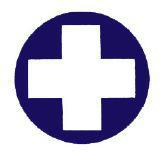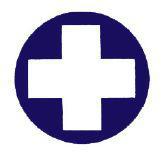SAS Urban Survival Handbook (122 page)
Read SAS Urban Survival Handbook Online
Authors: John Wiseman
Tags: #Health & Fitness, #Reference, #Survival, #Fiction, #Safety, #Self-Help, #Personal & Practical Guides, #General, #Survival Skills

SYMPTOMS
Chills and fever, breathlessness and a cough with greeny-yellow phlegm or sometimes blood. It may be difficult or painful to take air into the lungs. This may be due to inflammation of the lining of the chest and lungs (pleurisy).
ACTION
Seek urgent medical attention. Mild pneumonia usually responds well to antibiotic or antifungal drugs, depending on the cause of the infection, with paracetamol to reduce the fever. In some cases, particularly if the victim is elderly, hospitalization may be necessary.
TUBERCULOSIS (TB)
Tuberculosis is still a major problem in the Third World. It is an infectious bacterial disease—the bacterium is transmitted when the person sneezes or coughs. The immune system usually stops the infection, but scar tissue may be left in the lungs. In a small minority of cases the infection is more serious and may spread to other parts of the body. In these cases, further tissue damage may occur—especially to the lungs.
SYMPTOMS
Pain in the chest, a heavy cough, breathlessness, loss of appetite, loss of weight and a sweaty fever which may be worse at night.
ACTION
Seek urgent medical attention. If not treated early, the bacteria occasionally lie dormant in the lungs and other organs of the body, to be reactivated years later. Provided the full course of treatment is followed, most victims fully recover.
HYPERVENTILATION
Usually caused by extreme anxiety, hyperventilation takes the form of excessively deep or rapid breathing. Can also be caused by kidney failure, oxygen deficiency and diabetes.
SYMPTOMS
Over-breathing reduces the carbon dioxide in the blood, making it more alkaline, which tends to increase feelings of anxiety—making the problem worse.
ACTION
Breathing into a paper bag for a while should help to restore carbon dioxide to the blood. Even when the attack has passed, seek medical attention.
PANIC ATTACK
Sudden, often unexplained, attack of acute anxiety. The main outward signs are often hyperventilation, heart ‘palpitations’, sweating, shivering, fainting and tearfulness. Given the effect hyperventilation can have on anxiety levels, the victim should be encouraged to breathe into a paper bag for a few moments
while being calmed and reassured as much as possible. Attacks may be related to work, the home, crowds, public transport, being outside. Recurrent panic attacks may be symptoms of certain phobias and it is these phobias which should be treated. Attacks usually pass after a few minutes and, although very unpleasant, usually do no actual physical harm. Seek medical attention. There may be a help-group or counselling group which could provide support.
BRONCHITIS
Inflammation of the bronchi, the airways that connect the windpipe (trachea) to the lungs. Acute bronchitis may start suddenly but not last very long. Chronic bronchitis lasts longer and may recur over several years.
SYMPTOMS
Persistent coughing, large quantities of yellow or green phlegm, wheezing, breathlessness, discomfort in the chest and, in acute bronchitis, fever.
ACTION
Seek medical attention. Antibiotic drugs will help to treat or prevent a lung infection. In the case of chronic persistent bronchitis, a doctor will check that any blood coughed up is not a result of a more serious lung problem
PREVENTION
The most common cause of bronchitis is a history of smoking. Those who are subject to bronchitis, especially chronic bronchitis, would be extremely foolish to continue to smoke. Passive smoking, that is, being in an environment of cigarette smoke, may also lead to bronchitis.
EATING DISORDERS
 Every time we switch on a television or open a magazine, we are confronted with images of slim healthy people with perfect teeth and perfect lives. Young people, especially teenage girls, are particularly susceptible to this onslaught. At a time when their bodies are changing in a way they cannot control, young people may find that they can control their figures. They may begin to starve themselves for long periods of time (anorexia nervosa), or overeat in binges and then force themselves to vomit (bulimia nervosa). Both are dangerous. Seek medical attention.
Every time we switch on a television or open a magazine, we are confronted with images of slim healthy people with perfect teeth and perfect lives. Young people, especially teenage girls, are particularly susceptible to this onslaught. At a time when their bodies are changing in a way they cannot control, young people may find that they can control their figures. They may begin to starve themselves for long periods of time (anorexia nervosa), or overeat in binges and then force themselves to vomit (bulimia nervosa). Both are dangerous. Seek medical attention.
Obesity is in many ways the opposite of anorexia nervosa. Very overweight people consume far more in calories than their bodies are able to convert. If they do not have a network of friends or family to offer emotional support, people may resort to ‘comfort eating’, or deliberately gain even more weight as an expression of unhappiness.
An overweight person, as well as someone who appears to be healthy, may be suffering from malnutrition. A diet of ‘fast’ or convenience foods, chocolate bars and potato crisps, coupled with a social life based around restaurants and public houses, will not provide the balanced diet necessary for good health. The health of anyone, whatever their weight, will suffer. If you do live on pre-packed sandwiches and convenience foods or skip meals altogether, a multivitamin and mineral supplement may be advisable. Consult a doctor.
ANOREXIA NERVOSA
SYMPTOMS
Severe weight loss, with great lengths taken to avoid food. Anorexics may lie to their families, saying they have eaten out so that they can miss meals. Extreme choosiness over food, excessive exercise, use of laxatives, ‘baby’ hair on body, thinning of head hair and absence of menstrual periods. Anorexics often refuse to or are unable to recognize their thinness.
ACTION
Anorexia nervosa is difficult to treat and in rare cases may prove fatal. Hospital treatment is usual to help the person return to normal weight. He/she will often require psychotherapy for some time. Full recovery is possible. Under stress, relapses may occur. Doctors should be able to suggest self-help organizations which can be very supportive of former anorexics.
BULIMIA NERVOSA
Bouts of overeating followed by self-induced vomiting. Bulimia nervosa often starts as anorexia nervosa—in both there is a fear of becoming fat. Mainly affects girls and women between the ages of 15 and 30.
SYMPTOMS
Bingeing and vomiting may occur more than once per day. In extreme cases this may lead to tooth decay from gastric acids, dehydration and loss of potassium causing weakness and cramps. Bulimics may take laxatives to help ‘drive’ food from the body. They are not always very thin and may be of normal weight. They may be distressed about their compulsive behaviour, depressed or, in extreme cases, suicidal.
ACTION
Treatment is required to supervise and regulate eating habits. Sometimes psychotherapy and antidepressant drugs are used. Full recovery is possible, but there is a risk of relapse.
FOOD HYGIENE
 In recent years there have been well-publicized scandals connected with the food we eat—salmonella in eggs, for instance, and listeria in soft cheeses. Mass production of food may sometimes put profit before quality. Food-hygiene legislation is not always strict enough or properly enforced. The result is that food poisoning has increased—particularly in urban areas.
In recent years there have been well-publicized scandals connected with the food we eat—salmonella in eggs, for instance, and listeria in soft cheeses. Mass production of food may sometimes put profit before quality. Food-hygiene legislation is not always strict enough or properly enforced. The result is that food poisoning has increased—particularly in urban areas.
Take care to store and prepare food carefully in your home. Bacteria need food, warmth, moisture and time to multiply. They cannot grow on dried or dehydrated foods, which are safe until rehydrated. Bacteria thrive at 37° C (98.6° F)—body temperature—multiplying every two to 20 minutes. Danger zones are between 5° C and 63° C (40° F to 145° F). Normal room temperatures are within this range, so avoid leaving food out of the fridge for too long. A fridge thermometer will give a very accurate temperature reading.
BE SAFE, NOT SORRY
Simple food hygiene measures can virtually eliminate the risk of poisoning or contamination:
- ■
Always wash your hands before and DURING food preparation—especially after handling meat and poultry, rubbish bins and after using the lavatory. - ■
Always rinse cutting boards and utensils after each type of food, to avoid cross-contamination, especially of raw and cooked meats. - ■
Always wash fruit and vegetables thoroughly in clean water. - ■
Throw away anything that smells or looks spoiled, bulging or rusting tin cans, any food that has passed its sell-by/use-by date, mussels that do not open when cooked. - ■
Make sure that frozen poultry is completely thawed before use, and then well-cooked. - ■
Keep refrigerators between 2° C and 5° C (35° F and 40° F). - ■
Keep freezers at - 18° C (-0.4° F). Check the temperature of refrigerators and freezers regularly with a thermometer. - ■
Heat food such as soups and pies to a temperature of at least 63° C (145° F). - ■
Do not reheat food more than once. - ■
If using a microwave, check that food is cooked all the way through. - ■
Never leave foods such as butter, cheese and meats at room temperature. - ■
Never keep cooked and uncooked foods together. - ■
Change dishcloths and teatowels every day. - ■
Never allow pets, their hairs or cat litter on to work surfaces, especially if there is a pregnant woman in the house. - ■
Do not wrap cheese and other fatty goods in cling film (it contains a possibly dangerous chemical which may leach into fats). - ■
Babies, toddlers, pregnant women and the elderly should not eat eggs, unless these are cooked until both the whites and yolks are solid. - ■
Never brush or spray hair in the kitchen or near food; if your hair is long, keep it covered or tied back. - ■
Never smoke whilst preparing food.
Animals and food hygiene
Animals and food hygiene do not go together. Domestic pets and pests can cause diseases (see
Pets and your health
). Mice or rats can be detected by droppings, damaged packaging, spilled foods and broken eggs.
Mice
are not usually a serious threat to health, but they are unhygienic. They are attracted by fallen scraps of food, so floors should be kept clean. Humane traps, which capture mice alive, can be used to reduce numbers, but mice tend to move around houses under floors, through wall cavities and roof spaces, and are therefore difficult to eradicate completely. Call your local environmental health officer or a specialist if the problem persists.
Rats
pose a serious health risk and are increasingly prevalent in cities. They can be killed using anticoagulant poisons, but should be dealt with only by a specialist.
Bats
are generally harmless to humans in temperate zones. Indeed, they are a becoming increasingly rare and are a protected species. It is illegal to interfere with them, or their nests. Call your local authority for advice.
Cockroaches
may pose serious health risks—they may carry salmonella and hepatitis in their faeces. A severe infestation may be difficult to remove. Seek expert assistance.
FOOD POISONING
When a naturally poisonous substance or contaminated food has been swallowed, it is VITAL to pinpoint the source. There are many poisonous mushrooms, toadstools and poisonous plants. Vegetables and fruit that are normally safe may be contaminated by high levels of pesticide or fertilizer. Food may have been incorrectly stored or prepared. Sometimes, symptoms may develop rapidly or they may appear over a couple of days.